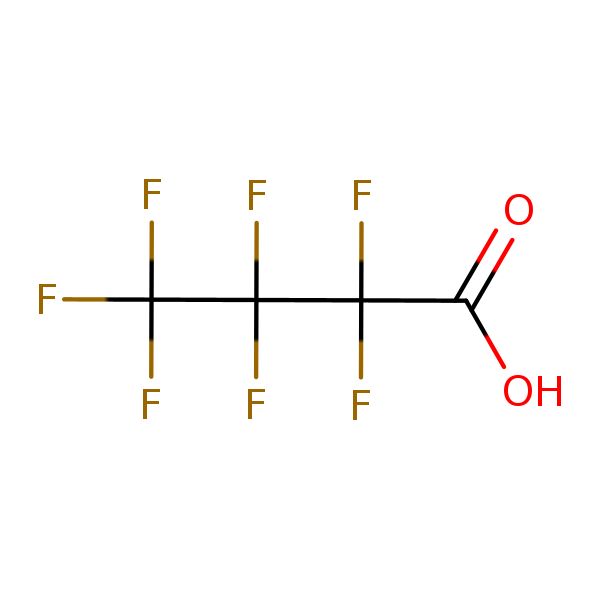Perfluorobutanoic Acid (PFBA)
CASRN 375-22-4 | DTXSID4059916
Toxicological Review of Perfluorobutanoic Acid and Related Compound Ammonium Perfluorobutanoic Acid (PFBA) (Interagency Science Consultation Draft, 2020)
On this page:
Alert
Notice - This site contains archived material(s)
Archive disclaimer
Archived files are provided for reference purposes only.
The file was current when produced, but is no longer maintained and may now be outdated.
Persons with disabilities having difficulty accessing archived files may contact the IRIS Webmaster for assistance.
Please use the contact us form if you need additional support.
Overview
In August 2021, the draft Toxicological Review of Perfluorobutanoic Acid and Related Compound Ammonium Perfluorobutanoic Acid (PFBA) (Public Comment and External Review Draft) and the draft charge to external peer reviewers were released for a 60-day public review and comment period. The Toxicological Review and charge were reviewed internally by EPA and by other federal agencies and White House Offices before public release. Consistent with the May 2009 IRIS assessment development process, all written comments on IRIS assessments submitted by other federal agencies and White House Offices are made publicly available. Accordingly, interagency comments and the interagency science consultation materials provided to other agencies, including interagency review drafts of the Toxicological Review and the charge to external peer reviewers, are posted on this site.Background
Perfluorobutanoic acid (PFBA, CASRN 375-22 -4) and its related salt (ammonium perfluorobutyric acid; NH4+PFBA, CASRN 10495-86-0) are members of the group per and polyfluoroalkyl substances (PFAS). Concerns about PFBA and other PFAS stem from the resistance of these compounds to hydrolysis, photolysis, and biodegradation, which leads to their persistence in the environment. PFASs are not naturally occurring in the environment; they are man-made compounds that have been used widely over the past several decades in consumer products and industrial applications because of their resistance to heat, oil, stains, grease, and water. PFBA is a breakdown product of other PFASs that are used in stain-resistant fabrics, paper food packaging, and carpets; it was also used for manufacturing photographic film, and it is used as a substitute for longer chain perfluorocarboxylic acids (PFCAs) in consumer products. PFBA has been found to accumulate in agricultural crops and it has been detected in household dust, soils, food products, and surface, ground, and drinking water. As such, exposure is possible via inhalation of indoor or outdoor air, ingestion of drinking water and food, and dermal contact with PFBA-containing products.| Date | Description |
|---|---|
| Nov 2019 | EPA released the Systematic Review Protocol for the PFAS IRIS Assessments (Preliminary Assessment Materials). [Federal Register Notice Nov 8, 2019] |
| Jul 2020 | EPA released an update to the Systematic Review Protocol for the PFBA, PFHxA, PFHxS, PFNA, and PFDA IRIS Assessments in response to public comments. |
| Aug 2020 | EPA sent an interagency science consultation PFBA draft for review and comment. |
| Aug 2021 | EPA released the draft IRIS Toxicological Review of Perfluorobutanoic Acid (PFBA) and Related Compound Ammonium Perfluorobutanoic Acid for a 60-day public comment period and external peer review. Additionally, EPA announced the solicitation for the nominations of members to a PFAS IRIS Review Panel that will review all five assessments. [Federal Register Notice Aug 23, 2021] |
Status
The Perfluorobutanoic acid (PFBA) IRIS assessment was released for public comment in Aug 2021. Following the public comment period, there will be an external peer review. The assessment will then be revised taking into consideration public and peer review comments.Download(s)
This download(s) is distributed solely for the purpose of pre-dissemination peer review under applicable information quality guidelines. It has not been formally disseminated by EPA. It does not represent and should not be construed to represent any Agency determination or policy.
- IRIS Toxicological Review of Perfluorobutanoic Acid (PFBA) and Related Compound Ammonium Perfluorobutanoic Acid [Interagency Science Consultation Draft] (PDF) (119 pp, 2.7 MB, about PDF)
- PFBA Supplemental Information - Appendix A - An Update to the Systematic Review Protocol for the PFAS IRIS Assessments (PDF) (208 pp, 2.9 MB, about PDF)
- PFBA Supplemental Information - Appendix B to E [Interagency Science Consultation Draft] (PDF) (89 pp, 1.4 MB, about PDF)
- 1. ATSDR PFBA IASC Comments Aug 2020 (PDF) (2 pp, 134.8 KB, about PDF)
- 2. DoD PFBA IASC Comments Aug 2020 (PDF) (10 pp, 567.4 KB, about PDF)
- 3. NIOSH IASC Comments Aug 2020 (PDF) (3 pp, 122.1 KB, about PDF)
- 4. OMB PFBA IASC Comments Aug 2020 (PDF) (1 pp, 122.1 KB, about PDF)
If you have a disability and the format of any material on our web pages interferes with your ability to access the information, please reach out to us using the Contact Us about IRIS form for assistance. To enable us to respond in a manner most helpful to you, please indicate the nature of the accessibility problem, the web address of the requested material, your preferred format in which you want to receive the material (electronic format (ASCII, etc.), standard print, large print, etc.), and your contact information.
Document Related Link(s)
Related Links
Critical Effect Systems
Chemical Structure for
Perfluorobutanoic Acid (PFBA)




